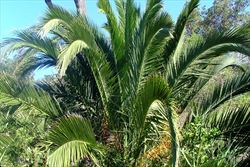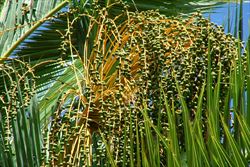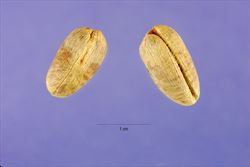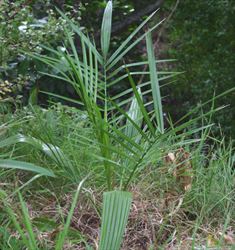Click on images to enlarge

naturalised plant growing in coastal vegetation (Photo: Sheldon Navie)

habit (Photo: Sheldon Navie)

thick main trunk (Photo: Sheldon Navie)

large leaves with numerous elongated leaflets (Photo: Sheldon Navie)

spiny leaf bases and old flower clusters (Photo: Sheldon Navie)

large clusters of flowers and immature fruit on yellow flowering branches (Photo: Sheldon Navie)

immature fruit (Photo: Sheldon Navie)

close-up of seeds (Photo: Steve Hurst at USDA PLANTS Database)

young plant (Photo: Trevor James)
Scientific Name
Phoenix canariensis hort. ex Chabaud
Family
Arecaceae (Queensland, New South Wales, the ACT, Victoria, Tasmania, Western Australia and the Northern Territory)Palmae (South Australia)
Common Names
Canary Island palm, Canary Island date palm, date palm, phoenix palm
Origin
Native to the Canary Islands.
Naturalised Distribution
This species is becoming naturalised in many parts of south-eastern Australia, though it currently has a scattered distribution. So far, it has been recorded in some parts of eastern New South Wales and Victoria, and in south-eastern South Australia. It is also sparingly naturalised on Norfolk Island and possibly naturalised in south-western Western Australia and south-eastern Queensland.
Also naturalised overseas in Europe (i.e. France and Italy), north-western Africa (i.e. Morocco and Tunisia), Mexico, southern USA (i.e. California and Florida) and New Zealand.
Notes
Canary Island palm (Phoenix canariensis) is regarded as an environmental weed in Victoria and New South Wales.

